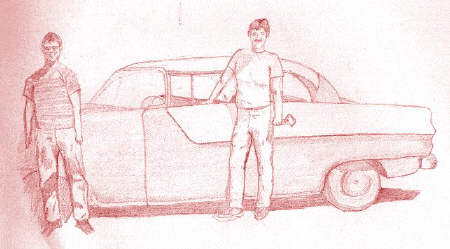
FISH, FROGS, AND FORKS

This story first appeared in the Spring 1984 issue of Modern Catapultry under the title of "Catapults, Carp, and Calaveras County Jumpers". It is complied from a multitude of fishing and frog hunting expeditions and a tremendous volume of imagination (which is just a fancy way of saying I made most of this up).
Mick and I had been planning this weekend all winter and part of the spring. We had hunted carp and frogs with a bow and arrow for many years and had taken frogs with a slingshot. This year we were going to attempt to shoot carp with a slingshot.
We had decided to go to the drainage ditches in the Illinois River bottom for our first attempt to shoot carp with a slingshot as it would be easier to see and retrieve them in the shallower water.
We were up early Saturday morning and, after a quick breakfast, began to load our equipment into Mick’s ’55 Pontiac, our huntin’ and fishin’ car. We both had our bowfishing rigs with a quiver full of field arrows. Mick had a couple of slingshots while I had the usual assortment of 8 to 10. We also had spare parts, extra bands, and all the other incidentals needed to keep a catapult functioning properly. Along with this, we loaded enough ammo to supply the 1979 Summer National Slingshot Tournament (which was the largest attended tournament with almost 200 participants).
After a short drive we arrived at one of our favorite "fishin’ holes". Leaving our bows in the car, off we trudged through the weeds and tall grass with just our slingshots. Almost immediately Mick spotted a carp feeding along the edge of the drainage ditch. A couple of shots sent him quickly on his way. We were both a little rusty and needed a few practice shots t warm us up before connecting with a carp. Although we felt several shots had hit, a carp hadn’t been stopped.
Finally it happened. Mick hit one in the head and after several wild thrashes in the water, it stopped. Needless to say, we were ecstatic; carp could be taken with a hand catapult. The hunt became very serious and before long a nice "mess of carp" had been harvested. By the time we were finished, we were soaked and covered with mud from wading through the muck, sliding up and down the banks, and making mad dashes into the water to grab a slowly sinking fish.
 It was time to find the
frogs. We loaded up and headed out for the "farm" and the frog pond where we
always found the most and largest frogs. As usual, the pond was encircled with tall weeds,
thick grass, and cattails, which kept us hidden from the frogs and vice versa. This mixed
blessing is strictly to the frog’s advantage because they know exactly where we are
by the noise we make.
It was time to find the
frogs. We loaded up and headed out for the "farm" and the frog pond where we
always found the most and largest frogs. As usual, the pond was encircled with tall weeds,
thick grass, and cattails, which kept us hidden from the frogs and vice versa. This mixed
blessing is strictly to the frog’s advantage because they know exactly where we are
by the noise we make.
Frogs can be both the smartest and dumbest of creatures. You can use your best sneaking technique, staying down wind and down shadow, to creep undetected close enough for a good shot just to have the frog jump into the water and disappear as you come to a full draw. Then at other times it is possible to walk up to a frog in full view and miss several shots almost surrounding it before it will jump. (Maybe they are not so dumb after all- knowing they are safe unless they move and accidentally jump into one of your shots!)
 Mick and I enjoyed good luck that
day and had our limit of bullfrogs in a short time. One of the techniques we use on a
small pond is to spot frogs for each other from the opposite side. As we locate frogs, we
take turns guiding each other into shooting range. As one of us talks to direct the other,
the frog is distracted by the talking as we silently (well almost) sneak up on it. This
isn’t as easy as it seems because the frog is usually backed up into a clump of
grass, hidden under a log, or in a small cave-like hole in the bank.
Mick and I enjoyed good luck that
day and had our limit of bullfrogs in a short time. One of the techniques we use on a
small pond is to spot frogs for each other from the opposite side. As we locate frogs, we
take turns guiding each other into shooting range. As one of us talks to direct the other,
the frog is distracted by the talking as we silently (well almost) sneak up on it. This
isn’t as easy as it seems because the frog is usually backed up into a clump of
grass, hidden under a log, or in a small cave-like hole in the bank.
 As we headed home with our catch, we laughed and talked about the fun we had
and the next expedition. Then that night we dined in style on delicious carp, frog legs,
and all the trimming to wrap up a perfect day.
As we headed home with our catch, we laughed and talked about the fun we had
and the next expedition. Then that night we dined in style on delicious carp, frog legs,
and all the trimming to wrap up a perfect day.
Back to Contents